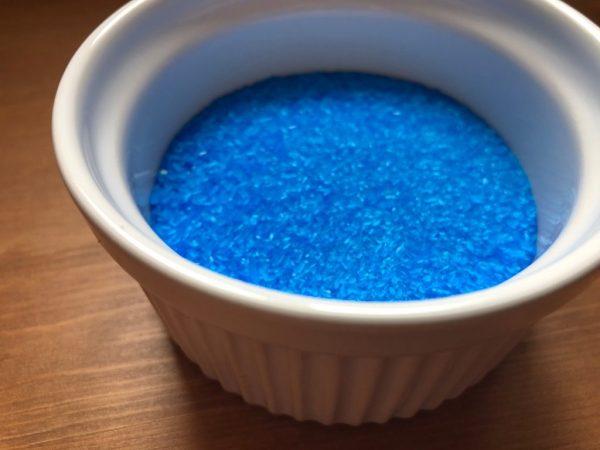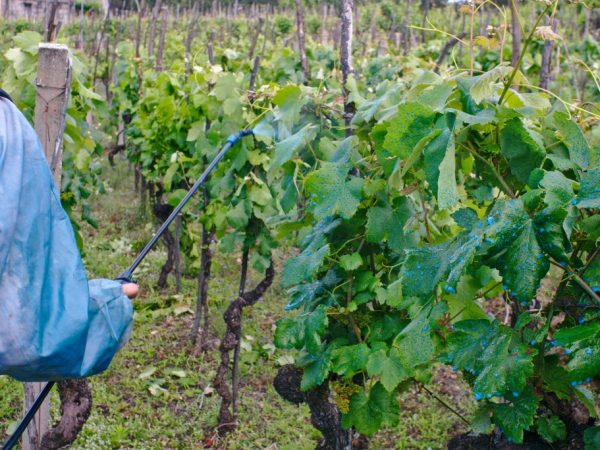Grape processing with copper sulfate
In viticulture, the healthy condition of the bushes plays an important role in obtaining a good harvest. To do this, they must be sprayed with special solutions. The processing of grapes with copper sulfate is carried out to destroy the causative agents of various diseases.

Grape processing with copper sulfate
Features of use
You can spray grapes with copper sulfate for the winter, spring and summer. Due to its composition, the solution is able to destroy pests and parasitic fungi that provoke diseases. It is recommended to use it not only in the presence of problems with the vineyard, but also to prevent the appearance of diseases.
It is believed that spraying bushes with copper sulfate in spring is dangerous. This is due to the fact that some substances of the solution are able to accumulate in the soil, impairing its fertile qualities and reducing the yield of vineyards.
If you follow the rules for using the drug specified in the instructions, and adhere to the recommended doses and proportions of the solution, you will be able to avoid problems and get a high-quality harvest.
After studying the properties of copper sulfate, drugs were developed against parasites and diseases with a wide spectrum of action, which retained all the qualities of the substance, but were less toxic.
Advantages and disadvantages
The use of copper sulfate for grapes has both positive and negative sides.
Solution advantages:
- the chemical is readily available commercially;
- the price of the drug is relatively low;
- the fungicide has a wide spectrum of action;
- copper sulfate actively destroys the fungus;
- the product is intended for the treatment of diseases and their prevention.
Disadvantages of the solution:
- high toxicity;
- the ability of a substance to accumulate in soil, plants and fruits;
- the properties of the drug have not been improved for a long time.
The disadvantages of copper sulfate also include possible burns to leaves and roots. They appear if the drug is diluted incorrectly. Despite this, the processing of grapes with copper sulfate is still carried out: it has been tested for decades and its price category is very affordable, which is of great importance when owning large vineyards.
Recommendations for use
Fungicide does not work well with top dressing, because when it gets into the soil, it destroys not only bacteria and fungi, but also useful microelements contained in the soil. Any organic fertilizers applied to the soil as a top dressing almost completely lose their properties in the process of interaction with lime and copper sulfate, so it is better to process the grapes with copper sulfate a week or a week after fertilization.

Spraying is best done after watering.
It is also not recommended to spray with a fungicide before watering the bushes: there is a possibility that the water will wash off the solution from the leaves. For the substance to work, it must be on the plant for at least a day, especially after removing the bush from the shelter.
Treatment with a pure solution of grape cuttings is undesirable: they are too sensitive to this chemical. For them, it is better to use a 4% solution prepared in proportions of 40 g of substance per 1 liter of water. There is another treatment option: dip the cuttings in liquid for 15 seconds.
Comparison of copper and iron sulfate
Iron sulfate is less toxic and cheaper. Its advantage is that it gives the grape bushes iron, which is involved in oxidative and energy metabolism and contributes to the formation of chlorophyll. Ferrous sulfate is used as a fertilizer and as a remedy for pests and fungal diseases. However, its insecticidal properties are not as effective as copper sulfate.
After processing the vineyard with iron vitriol in the spring, the buds open a few days later. Its use makes sense during the frost period in order to prevent kidney death.
Solution preparation rules
A solution of copper sulfate is also called Bordeaux liquid. To prepare it, you need 100 g of copper sulfate, 10 liters of water, lime. The suspension is easily prepared: vitriol is dissolved in warm water, lime and water are separately mixed to form milk of lime, after which the previously obtained solution is added to it.
You need to dilute the components in plastic or stainless steel buckets / containers. It is forbidden to use metal utensils.
To determine whether the solution is of high quality, pay attention to its color. A light blue shade of the liquid means that the suspension is prepared correctly, and green means that the solution is too acidic. To reduce the acidity level, another portion of milk of lime is added to it.
The acidity is checked by dipping a new iron nail into the liquid: if after a while a plaque appears on it, the acidity level is increased.
The solution retains its properties for 24 hours, after which irreversible chemical reactions occur in it. Vineyards should be processed with them in 1-3 hours after preparation.
Vineyard processing time
Usually, grapes are sprayed with copper sulfate in early spring, when there are no leaves, ovaries and young vines on the bushes, or in the fall, after harvesting.
The timing of the treatment of grapes with this fungicide depends on the regions and climatic characteristics. In the south, spraying is done in mid-March, because at this time the vine is already beginning to grow, or after October (then it is better to use a 3% solution prepared in a proportion of 300 g of substance per 10 liters of water).
In the northern regions, the process is carried out taking into account the weather and the time of removing the shrub from the shelter. It is better to process the grapes until the first greens appear. If you spray a bush that already has leaves, there is a risk of burning them.
The second time it is better to process the bushes with 1% Bordeaux liquid: it is less acidic and is safe for swollen buds and first flowers.
Before treating the grapes with copper sulfate, you need to carefully inspect the bushes for the presence of pests and infected leaves and be sure to remove them. It is especially important to do this in the spring, because in winter some pests hide under the vines and on the back of the leaves. Before sprinkling the grapes, they slightly dig up the soil under it and use the permissible concentration rate so as not to damage the root.
In the summer, it is forbidden to use the fungicide in its pure form, because at this time brushes begin to appear and berries ripen. The use of Bordeaux liquid is allowed one month before harvest.
Conclusion
Increasingly, farmers prefer the treatment of grapes with copper sulfate, since this fungicide effectively fights pests and fungal diseases. In order for such a treatment to be safe for plants, it is important to observe proportions when preparing a solution and a dose when treating bushes with it.It is also worth adhering to the recommended timing of the procedure so as not to harm the young leaves.


